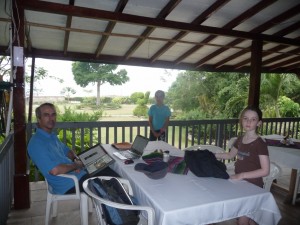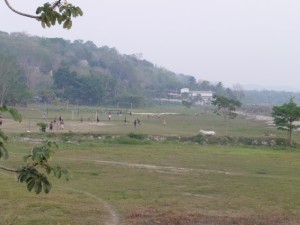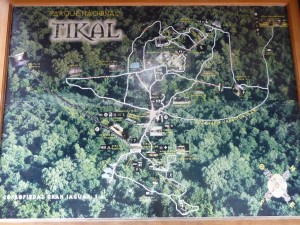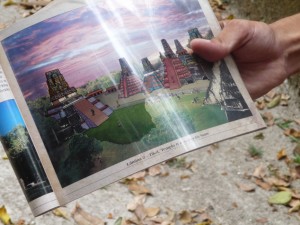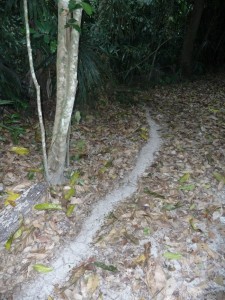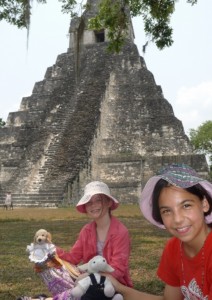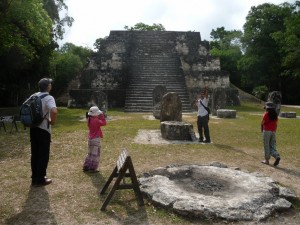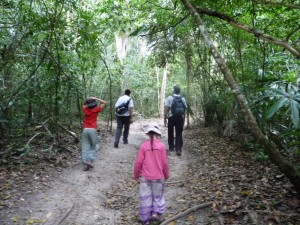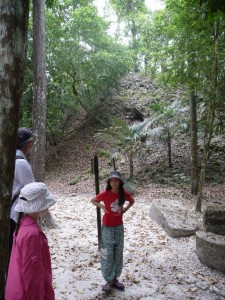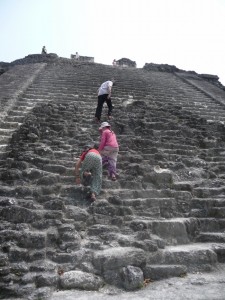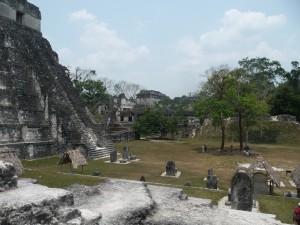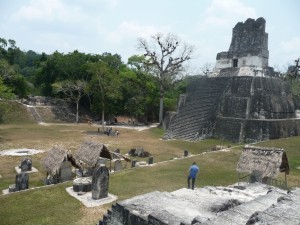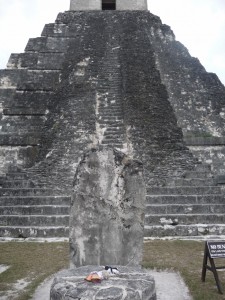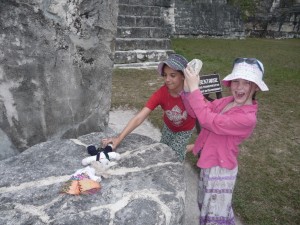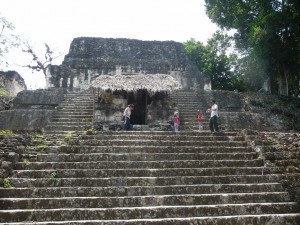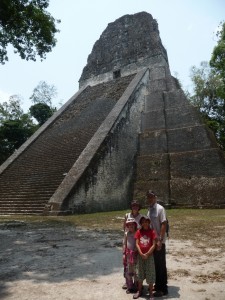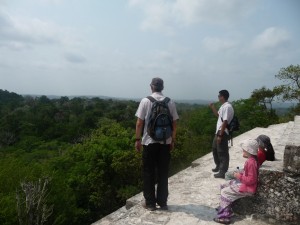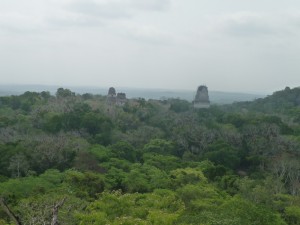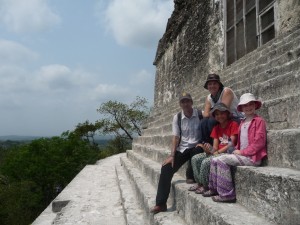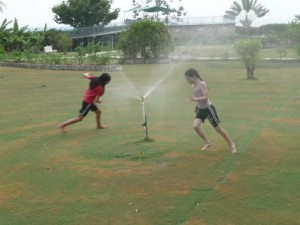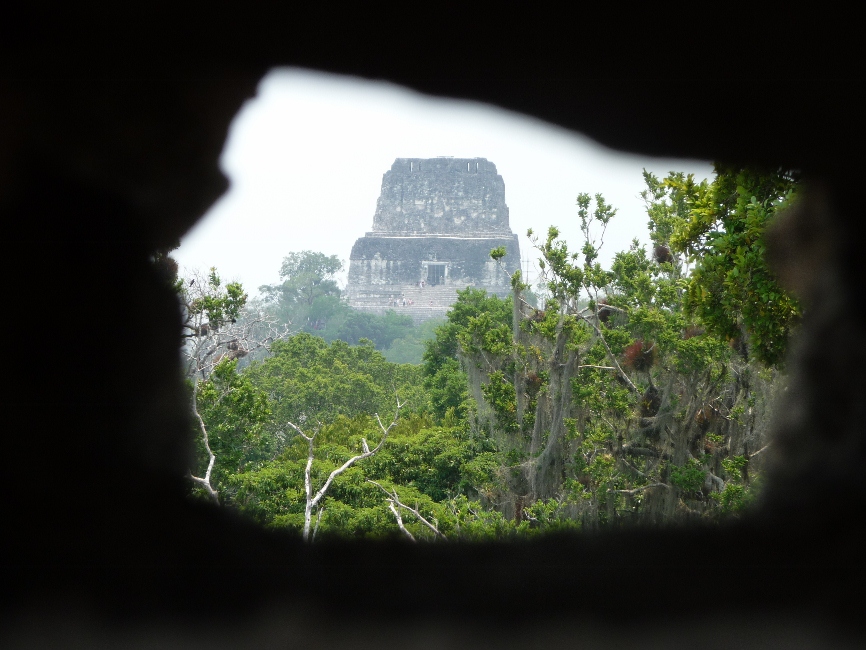Under the Ceiba tree:The World of the Mayans part 1
Posted by asuasu69 on May 22, 2013 in Belize, Guatemala | 0 commentsAfter spending our first few days at Flores, we were ready to begin exploring some Mayan ruins, and where better to start than Guatemala’s most famous: Tikal.
We moved around the lake to El Remate, a small woodcarving village of approximately 370 families, located on the east end of Lake Petén Itzá, for the next four nights staying at La Casa de don David (although we didn’t get to meet that David) #1 as voted by Tripadvisor and Travellers Choice for 2013 at around $82 per night for a private room with two double beds. It had plenty of space and large landscaped garden which is always welcome when travelling with kids!
At the centre of the garden was a Maya-inspired circle with the ‘Sacred tree of life’ and national tree of Guatemala as its centrepiece; the Ceiba tree.
According to the mythology of the ancient Maya, the great Ceiba tree stood at the center of the earth connecting our Earth world to the Spirit world in the heavens above. Early Maya writings tell of the trunk and branches supporting the sky and its roots represent the underworld hence the Maya believed the Ceiba Tree as an energy connection with the Cosmos, Earth, and the Underworld. Every Maya village, both ancient and modern, is centered around a Ceiba as this tree offers protection, enlightenment, prosperity and eternal life.
Cardinal points radiated out from the tree in different colours. East in red for the colour of the dawn, West was black as the direction of the sunset and symbolising darkness, North was white, associated with bright light and South was yellow, the colour of gold. Each of these points had coloured stones and lights and at night, fairy lights also adorned the Ceiba tree turning it into a little magical fairyland.
In the relative coolness of the evening (daytime temperatures were hovering around 42 degrees) we had many a game of spotlight (hide and seek with head-torches) with the girls around the gardens.
One meal per day was included in the accommodation, so we opted for dinner which turned out to be delicious home-cooked fare every time taken on the verandah overlooking the gardens and lake. Unfortunately we had no fridge in the room but breakfast is always easy to cater for having purchased the ever available packet of cornflakes and few tetra packs of long-life milk to last us, and purchasing a light lunch each day from the kitchen of the guesthouse.
We were now closer to Tikal and also to Yax-ha, another Mayan archaeological site that we would visit spending a few hours at each over the coming days.
To get to Tikal, about 30 minutes away, we booked transport and a guide through the guesthouse and headed there early one morning to avoid the hottest part of the day. Usually we muddle along without a guide, as past experience has taught us that the girls (and me for that matter) can only take in so much information as we go, preferring to do individual research. However for our first foray into the Mayan civilisations (and with plans to do more) we thought we best take a guide to get some basic and more insightful knowledge.
I had asked at the guesthouse whether any of the guides they used had young children of their own and they recommended this particular one as her had children around the same age as the girls, and I was able to speak to him on the phone so I could express my wish for more than just a lot of facts and figures and told him that girls are also interested in animals and he assured us that he would not go on too much about dates but interesting titbits of Mayan history and life in general.
He kept to his word, and showed us various flora and fauna, such as the leaf-cutter ant trails and, having kids of his own, was able to capture the girl’s attention for a good amount of time with appropriate language. He also had one of the books that had the now and ‘before’ depiction via a clear page that flipped over showing the pyramids in their glory – with different coloured stucco and friezes, the same kind of book that had captured the girls attention at Ephesus.
I have long been interested in Ancient civilisations so it was now time to get my head around the Maya Civilisation and how it fits with the Aztecs, and Inca’s having visited Machu Pichu in Peru some years ago. The Maya civilisation is the oldest of the three and Tikal was the Capital of a conquest state that became one of the most powerful kingdoms of the ancient Maya people. Some of their monumental architecture at the site dates back as far as the 4th century BC, but Tikal reached its peak during the years from 250 – 900 AD.
During its heyday, around 750AD, Tikal was the political, cultural, religious and military center of the Mayan civilization that spread over all the Yucatan Peninsula, lowland Guatemala and western Honduras, and was ruled by kings who passed the throne to their heirs.
My first impressions of the Mayan architecture were, unfortunately, one of disappointment. It didn’t have elaborate bas-relief carvings like Angkor Wat, or the precisely cut and shaped massive stones sans mortar of the Inca’s.
The ancient city of Tikal lies within a biosphere preserve, the Peten rainforest. Under the rainforest, the ground is made up of limestone, which was used by the Maya to construct the city. Much of the ‘city of Tikal’ as with other Mayan site’s, is still under the cover of dense jungle awaiting further funding to be explored. The large pyramids are actually temples that were erected to honor kings when they died. A series of causeways links different areas of the city and runs between major structures.
Feeling underwhelmed by it all, it wasn’t until I realised that they thrived as a civilisation for nearly 2000 years, that they managed to build these massive stone structures with the only material they had – limestone, and all without the use of metal tools. They were also accomplished scientists, tracking a solar year of 365 days and one of the few remaining Maya books contained tables of eclipses. They tracked and studied the planet Venus from their observatories. They developed their own mathematics, using a base number of 20, and had a concept of zero. Their civilisation was so stable and established, they even had a word for a 400-year time period. OK – now they were pretty impressive…
The Mayan script or writing system, known as hieroglyphs, were carved into stelae (large stone monuments) and these stone carvings are very weather-beaten and often have replicas of the originals in place. Mayan society was vibrant, but it was also very brutal. It was strictly hierarchical and deeply spiritual. Humans were sacrificed to appease the gods. Sacrificial ceremonies and rituals were commonplace and the girls eagerly pointed out the sacrifice tables in front of many of structures and even ‘sacrificing’ toys Scruffy and Baa-Baa in a re-enactment.
Besides the stepped pyramids, that were often built in nine levels each representing a level of the underworld, also synonymous with nearly every Maya archaeological site was a ball court. Because of its central locations it was assumed that the ball game was not simply entertainment. Instead, it could also be used ritually, to test the will of captives before they were sacrificed. To the Maya, the ball game referred to life and death. The ball, it has been suggested, was a reference to the sun, moving through the sky. The ball game sometimes ended with the sacrifice of a player, which symbolized the idea of death and rebirth. Through sacrifice, the sun would be sustained so it would rise again, promising renewal and fertility for crops. Such a sacrifice would be visible to everyone around the grand plaza at Tikal.
I was surprised about the sheer size of Tikal, once supporting a population of up to 100 000 people and how it is just overgrown with jungle as after the Maya abandoned Tikal the city was reclaimed by the jungle with 80% of the ruins still unexcavated. It has an estimated 3000 structures including temples, palaces, shrines, residences, ball courts, terraces, causeways and plazas and they are mostly interconnected with aquaducts and cisterns for holding water.
There are 5 large temples with Temple IV or the Temple of the Double Headed Serpent the highest at 70 metres. It was this temple that we climbed (wooden stairs most of the way and then onto the temple itself) for a magnificent view over the treetops to capture the view as seen in scene in the original Star Wars as Tikal was the setting for the rebel base on Yavin. David was especially excited about this, however he had to show me a youtube clip later of that particular scene to prove it was indeed the location having never been a Star Wars fan.
Interestingly, by 900 AD Tikal ceased to exist with the city and those of other Mayan sites being abandoned by reasons still being explored by archaeologists. Possible resource depletion has been cited as a contributing factor, but more recently evidence of an exceptional drought at the time of the Maya collapse from dating core samples of the mud from the bottom of a lake. A core from the ninth century showed an exceptional surge of heavy oxygen, indicating it was the driest time in the region for 7,000 years.
We were back at our guesthouse by around 1pm and stayed in thankful for the air-conditioning in our room. The girls had fun running around the gardens and getting soaked by the sprinkler that afternoon while Dave and I enjoyed a couple of cold ‘Gallo’ cervezas.


